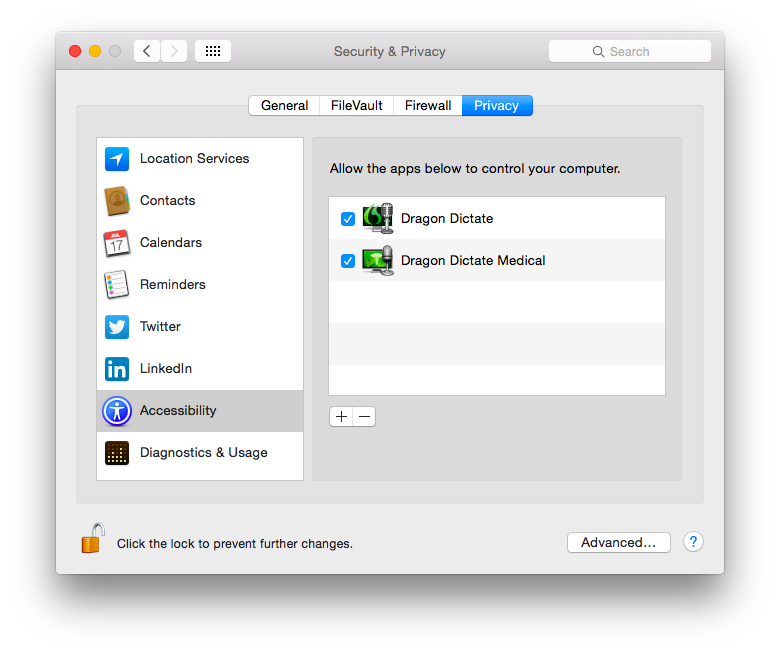- The new OS from Mac is here in OS X El Capitan. Apple's 12th OS release is the OS X El Capitan.Named after a rock formation in the Yosemite National Park, USA, OS X El Capitan continues and focuses on stability, performance and security in which OS X Yosemite started. With this new OS, you can enjoy multitasking in full screen with Split View, control your desktop without overlapping with.
- Mar 22, 2016 Apple explains that while all iCloud users can enable two-factor authentication today, at least one of their devices needs to be running iOS 9 or OS X El Capitan. Apple’s list of recommended.
Setup a Network Between OS X El Capitan and Windows 10. Before you begin, check to make sure both operating systems are updated.On OS X head to the Apple, menu App Store Updates to make sure.
| Click here to return to the 'Enable and disable Assistive Devices via Terminal' hint |

---
-J-

How To Enable Access For Assisticve Devices Macbook El Capitan Download
tell application 'System Events'
set UI elements enabled to true
end tell
The user will get prompted to enter their credentials. No need to use the do shell script.
So, to be safe, it appears it would be better to: ..instead.
 Argh - submitted too soon..
Argh - submitted too soon.. Almost correct: The file should NOT contain the trailing newline. So, that means it should be: (with the extra '-n' switch passed to echo) Valve proton for macos.
Word, Excel, PowerPoint, Outlook, OneDrive, Skype for Business, and OneNote will install and run on macOS 10.14 Mojave. Microsoft fully supports Office 2016, Office 2019 and Microsoft 365 for Mac on 10.14 Mojave when you have the following Office updates installed: Microsoft 365/2019 - Build 16.17.0 or later. Office 2016 - Build 16.16.2 or later. May 11, 2020 Additionally, some scammers may try to identify themselves as a Microsoft MVP. Microsoft Excel for Mac (16.19) running on macOS Mojave crashes Split from this thread. I have the same problem and this does not fix it. Only Excel is affected. This thread is locked. You can follow the question or vote as helpful, but you cannot reply to this. Apr 28, 2020 Check out our special offer for new subscribers to Microsoft 365 Business Basic. MacOS Mojave & Excel 2016 G'day! I am dealing with an issue with Excel for mac 2016. I'm not able to use the drop-down buttons in the ribbon on any spreadsheet. This issue also affects other Office products - specifically drop-down buttons. Oct 04, 2018 I have certainly loaded Excel and all appears to work, but I mostly use Word. In terms of this discussion: Also in case this is relevant to anyone; I clean installed Mac OS Mojave. I also clean installed Microsoft Office 2011 and applied the latest update. I have kept the.dmg files for both; hence a clean install was possible. Nov 29, 2018 1. Restart your Mac, close other 3rd party apps to avoid possible software confliction. Then open Excel again. Is it happening on a specific file only? Try to open Excel with a blank document and see if the issue will remain. Start your Mac in Safe Mode and open Excel from there. You can refer to the article below. Microsoft excel for mac os mojave download.
Sorry about that..
I figured out it would even be better to change that into:
sudo echo -n 'a' > /private/var/db/.AccessibilityAPIEnabled
sudo chmod 444 /private/var/db/.AccessibilityAPIEnabled
Not using the -n would leave an 'a' followed by a 'newline' inside the file instead of just the 'a'
How To Enable Access For Assisticve Devices Macbook El Capitan 2
It is useful to point out that System Preferences should not be open during this procedure. I discovered this while debugging a script that used the aforementioned code while I had the Accessibility prefpane open.
In Snow leopard I find that this does not work. It creates the hidden file, places the 'a' within, and in system preferences the 'enable access for..' is checked, but my applescripts still say 'access for assistive devices is disabled'. Only once I manually check the checkbox do the scripts work. This leads me to believe that something else, other than the .AccessibilityAPIEnabled file is happening under Snow Leopard.
My whole goal is to have a window/app management script that launches and places all of my startup apps/windows for dual monitors. I despise the automated mouse movement that comes with 'access for assistive devices' but I need this to move and resize the windows so in a single applescript i want to:
1. turn the access on
2. move and place the windows
3. turn the access off



